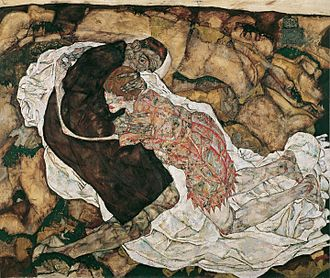Nosferatu (2024): a review to whet the appetite
Words by Arabella Green and Madeleine McClean
If our reviews whet your appetite for some more horror, come along to the opening night of the Norman Rea Gallery’s next exhibition: ‘Adrenaline Junkie’. Opening February 5th, in the Gallery.
Arabella thinks:
Nosferatu (2024) is a cruel exploration of “appetite” and death.
Though we have seen countless iterations of Bram Stoker’s Dracula over the years, this version captures the Gothic tale’s truly terrifying and vicious undercurrent.
The story unfolds like a terrible fairytale, some foul variety of ‘Beauty and the Beast’, and definitely challenges many horror tropes like the disbelieved woman and the final girl.
In the original 1922 film, Nosferatu: A Symphony of Horror, Ellen asks her husband: “Why did you kill them... the lovely flowers…?”. This line is reiterated, though with a new and refreshing anger, and cuts to the heart of Ellen’s self-aware fate.
Still from ‘Nosferatu’ (2024), directed by Robert Eggers
Director Robert Eggers maintains an at-times disgusting emphasis on body horror, and Lily-Rose Depp’s visceral physicality was easily the masterstroke of her performance.
This is obvious from the start, the very first scene being a haunting portrait of nightmare, possession, convulsion, and wet dream.
The illicit sexuality of the film is fascinating and true to the vampiric tradition. The very act of bloodsucking is an oral transgression, something 19th century Europe certainly viewed as a veiled metaphor for sexual deviancy, and something I think the 21st Century is further building on as a commentary on trauma and lost agency.
Still from ‘Nosferatu’ (2024), directed by Robert Eggers
The colour scheme of blues and yellows was shot via custom-made lens filters and really accentuated an eerie coldness of Nosferatu’s aesthetic. It felt vintage and paired beautifully with the historically-accurate costumes and detailed sets.
The most jarring part of any horror film is always the score and Nosferatu did not disappoint. At times the music was like screaming or fingernails across a chalkboard. Even when you know the story, you’ve heard it hundreds of times and you’re not afraid, Nosferatu’s soundtrack will get to you if nothing else.
Still from ‘Nosferatu’ (2024), directed by Robert Eggers
Maddie thinks:
Nosferatu will have turned 103 this year, which is still relatively young for a vampire. Since his conception in 1922 he’s re-invented himself a number of times, first at the hands of Werner Herzog and now with the masterful direction of Robert Eggers. From German Expressionism to German Realism, to Eggers’ magical realist blend of the two. He is, of course, already a reinvention, almost a facsimile, of the original ‘Dracula’ (1897) story (to the extent that Bram Stoker’s widow once sued for copyright infringement). Like a bacteria he mutates and spreads his art like the plague, invariably returning to haunt his captive audiences. And yet we welcome him back, devising new ways to heighten the horror and selling out movie theatres on New Year’s day. There is something irresistibly repulsive about the Count - he speaks to our sense of Thanatos (the ‘Death Drive’), which Freud theorises can only be countered with Eros (the ‘Sex drive’). And, spoiler alert, there is a lot of death and sex in this film. A film which seduces with its cinematography, its costuming, its physical theatre. It does have its weaknesses; the pacing drags a little at times and sorry Skarsgard but your Orlokian tones almost had me at times in tears of mirth instead than fright. But it’s definitely worth a watch; for a film about the clash of the irrational ‘medieval’ and the supposedly rational ‘modern’, it would be madness not to go.
If you aren’t yet convinced, I’ve compiled a summary of the film in paintings. See if you can spot the references throughout the film!
Caspar David Friedrich, Moonrise by the Sea, 1822.
The set designer for the film is said to have drawn inspiration from this painting. Windswept coasts and dramatic landscapes give the film its Romantic Gothic feel. The film’s architecture is also reminiscent of the Hanseatic style, which was prevalent in the Baltic coastal areas of Friedrich’s childhood and is echoed in some of his work.
Henry Fuseli, The Nightmare, 1781
Within minutes this one will make sense, as the film opens with a shot of the inside of one of Ellen’s many nightmares. That oppressive creature has Orlockian eyes and it straddles the same fine line between beast and man.
Charles Bell, ‘The Wounded Following the Battle of Corunna: Tetanus Following Gunshot Wound’, 1809
The physicality of Ellen’s possession by the Count was impressively and horrifyingly conveyed by Lily Rose-Depp. Inspired by Isabelle Adjani’s performance in ‘Possession’ (1981), she twisted and convulsed in a most unnatural way, as though her body really had been hijacked by evil forces…
Egon Schiele, ‘Death and the Maiden’, 1915
This one might be a bit more obvious. ‘Nosferatu’ is another iteration of many examples of the ‘Death and the Maiden’ trope in art. Whilst it’s tempting to comfortably dismiss Count Orlock and Ellen’s relationship as entirely one-sided and predatory (and predatory it is), it is hard to ignore Ellen’s reciprocated desire for him, for Death. It is a dark and unwanted desire but it persists, and is consummated in an embrace akin to Schiele’s vision.







